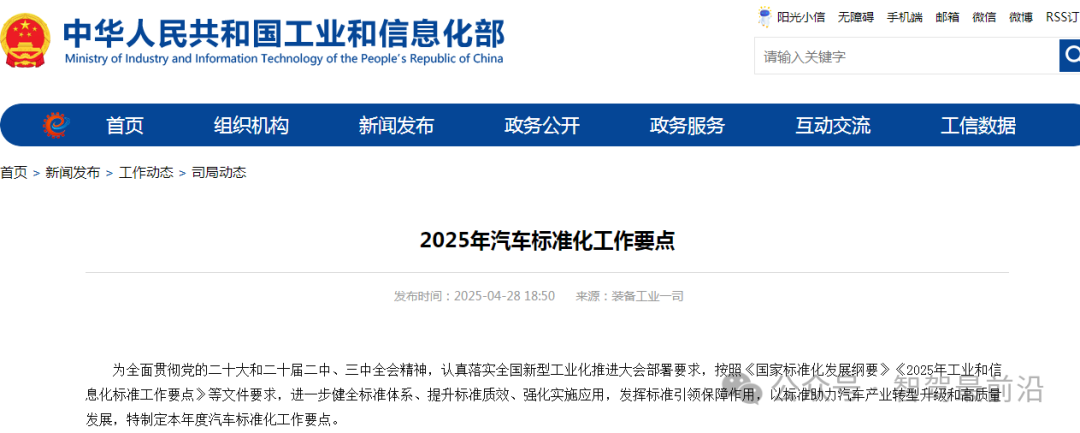What requirements does the 'Key Points of Automotive Standardization Work in 2025' impose on the autonomous driving industry?
![]() 05/06 2025
05/06 2025
![]() 689
689
On April 28, 2025, the First Department of Equipment Industry of the Ministry of Industry and Information Technology released the 'Key Points of Automotive Standardization Work in 2025' (hereinafter referred to as the '2025 Key Points'). If China's automotive industry is compared to a high-speed train, then these key points serve as the 'standardized tracks' laid for it. Upon carefully reading the '2025 Key Points', we find that specific requirements for the autonomous driving industry are proposed, providing solid 'hardware' support for the development of intelligent driving. Today, let's discuss the intelligent driving-related content in the '2025 Key Points' (click 'Read the original text' at the end of the article to view the full text of the key points).


Screenshot (partial) of the '2025 Key Points', source: Official website of the Ministry of Industry and Information Technology

What are the changes in requirements for intelligent driving in 2025 compared to 2024?
Compared to the 2024 version, the 2025 Key Points in automotive standardization have achieved a critical leap from 'macro planning' to 'fine-grained implementation' in the field of autonomous driving. In layman's terms, the '2025 Key Points' are more 'down-to-earth' in terms of requirements related to autonomous driving.

Screenshot (partial) of the 'Key Points of Automotive Standardization Work in 2024', source: Official website of the Ministry of Industry and Information Technology
The 2024 version mainly focused on initiating and drafting standards for general technical requirements, road test methods, and information security for autonomous driving. In contrast, the 2025 version further elevates 'safety requirements for autonomous driving systems' to a compulsory national standard, clearly establishing a 'quantifiable, verifiable, and traceable' safety baseline. This means that not only are obligatory basic safety indicators (such as perception redundancy, functional failure switching delay, software rollback capability, etc.) required, but specific testing methods and pass thresholds must also be provided in the standard text, thoroughly breaking the past situation of numerous 'principled' and 'guiding' clauses leading to uneven implementation effects.
Although the 2024 version proposed the development of standards for autonomous driving simulation test methods, it did not include them in the mandatory testing category. The 2025 version not only accelerated the approval and publication of this standard but also included autonomous parking, automatic emergency braking, and simulation test scenarios into a unified assessment system for the first time, establishing a comparable and closed-loop verification chain between simulation platforms and real vehicle testing. This full-process standard closed loop, from 'design indicators to simulation verification to real vehicle testing', not only provides a clear R&D-testing-compliance path for platform developers but also significantly enhances the safety and reliability of autonomous driving functions in multi-dimensional scenarios such as complex traffic and extreme weather.
Additionally, the 2025 version incorporates 'automotive cryptographic technology requirements', 'security gateways', and 'data security management systems' into the compulsory or recommended standard system for the first time, covering the entire link protection from the vehicle end, road end, to the cloud end. Compared to the mostly conceptual deployments in 2024, the 2025 key points propose more detailed requirements for standard implementation mechanisms, audit processes, and vulnerability responses, ensuring that critical links such as OTA upgrades, map and model distribution possess traceable and auditable security barriers. Overall, the 2025 key points truly push autonomous driving from 'pilot demonstrations' to a new stage of 'large-scale and safe commercial operations' through the design of standard implementation and closed-loop implementation.

Analysis of intelligent driving content in the '2025 Key Points'
The core competitiveness of autonomous driving lies fundamentally in 'being safer'. Prior to this, different enterprises operating independently with various internal evaluation standards have become significant constraints for the industry to achieve large-scale and safe implementation. The '2025 Key Points' propose accelerating the development of compulsory national standards for safety requirements of autonomous driving systems and establishing a safety baseline for autonomous driving systems. This means that the construction of standards must be 'quantifiable, verifiable, and traceable', from multi-sensor redundancy of perception hardware to failure mode response strategies for software control, to software and hardware fault detection and safety switching mechanisms, all of which must undergo unified and industry-recognized indicator assessments. For autonomous driving platforms, this is like equipping each vehicle with a 'national standard-level physical examination report'. Only systems that pass the 'physical examination' can obtain a 'pass' in the market. Platform manufacturers must also deeply embed these 'quantitative indicators' into the development process from the beginning of product design to ensure that algorithms and hardware maintain reliability in various complex scenarios. In other words, safety is no longer an added value that the R&D team can refine 'based on experience' or 'feelings'; instead, numerical safety thresholds must be clearly defined at the initial stage of requirements definition and continuously verified and optimized in subsequent version iterations.
While road testing is crucial in the field of autonomous driving, relying solely on unrestricted road test drives to validate system capabilities on a large scale and efficiently cannot meet the dual pressures of cost and time. In this regard, the '2025 Key Points' clearly propose promoting the approval, publication, and implementation of standards for autonomous driving design operating conditions, autonomous parking, and autonomous driving simulation testing. The underlying message of this measure is that autonomous driving simulation technology will become an indispensable testing ground for the autonomous driving industry. Developers can generate thousands of scenarios such as pedestrians crossing, vehicles braking suddenly, tunnel traversal, and extreme weather on the simulation platform with one click and quickly locate algorithm shortcomings based on unified evaluation indicators. Compared to traditional road testing, which requires a significant amount of manpower and material resources and has usage restrictions on road resources, simulation testing can be conducted around the clock and in batches, which is revolutionary for accelerating product iterations and ensuring system robustness. More importantly, when simulation testing standards are implemented simultaneously with real vehicle testing standards, autonomous driving-related enterprises can achieve a closed-loop process of 'simulation verification → real vehicle verification → compliance review', significantly shortening the time window from product development to implementation.
For autonomous driving to become smarter, it is not enough to rely solely on sensors and decision-making at the vehicle end; it must also coordinate with road infrastructure, traffic signals, and other vehicles. The '2025 Key Points' specifically mention accelerating the formulation of related standards for LTE-V2X direct communication, digital keys, platoon following, and network information assistance, which undoubtedly sounds the 'charge' for vehicle-road coordination technology. Imagine that when your driverless vehicle is traveling on a busy urban road, it can pre-obtain the timing sequence of traffic light switching from the roadside unit and the driving status from other vehicle fleets to achieve speed synchronization and route optimization. When it enters the underground garage of a business district, it can also unlock seamlessly, automatically find a parking spot, and park precisely through digital key technology. All of this benefits from the 'barrier-free dialogue' between vehicles and roads at the standard level. For autonomous driving platforms, it is necessary to connect these unified protocols and message formats at both the vehicle end and the backend to ensure that traffic infrastructure from different cities and different operators can smoothly exchange data, laying a solid foundation for the large-scale application of L3 and above-level autonomous driving, which definitely requires the promotion of standards.
In addition to vehicle-road coordination, the 'neural hub' of autonomous driving also cannot be separated from the escort of network and data security. The '2025 Key Points' emphasize promoting the publication and implementation of standards such as information security engineering, accelerating the formulation of compulsory national standards for automotive cryptography, completing the review of data security management systems and automotive security vulnerability classification and grading standards, accelerating the development of important data identification standards, and enhancing network security and data security assurance capabilities. This clearly sends a signal to the industry that data security and network security will no longer be functions that enterprises can 'choose to do'; instead, they are the bottom-line guarantees for the entire autonomous driving commercialization and compliance process and must be taken seriously. Platform operators need to deploy hardware security modules (HSM) that meet national standards at the vehicle end, establish encrypted communication channels between the vehicle and the cloud, and build a unified security operation and maintenance system at the backend, including vulnerability response, patch management, and authority auditing. Only in this way can vehicles complete the download of map updates, AI models, or OTA upgrades under a security audit and traceable mechanism, which not only enhances the system's resistance to attacks but also gives users greater peace of mind regarding the security performance of autonomous driving platforms.
In addition to the above aspects, the '2025 Key Points' also closely link intelligent connectivity and autonomous driving standards with other areas such as new energy vehicle standards, in-vehicle chip and electronic system standards, and green and low-carbon standards. This design not only avoids the fragmentation of standards but also provides more imagination space for the integration and innovation of autonomous driving and vehicle manufacturing. For example, with the successive introduction of standards for all-solid-state batteries, in-service inspection of power batteries, and thermal management systems, the precision of energy management and range prediction for autonomous driving vehicles will be further improved, enabling the autonomous driving system to remain stable in long-distance and extreme environments. In the field of in-vehicle chips, the improvement of standards for security chips, power drive chips, perception sensor chips, etc., means that autonomous driving platforms can more quickly select and integrate standardized components, reducing the 'break-in cost' between underlying hardware and upper-level algorithms, and further enhancing system reliability and computational efficiency.
Careful analysis of the '2025 Key Points' reveals that the series of standardization initiatives proposed provide three major guarantees of 'intelligence, safety, and scale' for the autonomous driving industry. From a safety perspective, a unified safety baseline makes the safety thresholds of the entire industry more transparent and measurable, providing a clear basis for regulatory authorities and third-party testing institutions. From an efficiency perspective, the introduction of simulation testing and vehicle-road coordination standards significantly reduces development and verification costs and improves R&D efficiency. From an ecological perspective, the implementation of network and data security standards helps build an open and trustworthy Internet of Vehicles ecosystem, enabling more innovative applications such as MaaS (Mobility as a Service) and vehicle-end AI computing power open platforms to be rapidly incubated in a secure and controllable environment.
In 2025, we are at a critical juncture for autonomous driving technology to transition from 'proof of concept' to 'demonstration applications' and then to 'large-scale commercial use'. Whether it is the arrival of the era of 'strong supervision' that has been widely publicized online recently or the series of standardization requirements proposed in the '2025 Key Points', we can all feel that the 'explosive period' of the autonomous driving industry is accelerating. For automakers, only by actively embracing standards and internalizing national standard requirements into product design and iteration processes can they seize the initiative in the increasingly fierce competition. For city managers and operators of transportation infrastructure, only by accelerating the construction and upgrade of vehicle-road coordination infrastructure can they better undertake the large-scale application of autonomous driving vehicles. For ordinary users, with the implementation of standard dividends, driverless travel will become safer, more convenient, and more 'trustworthy'.
Looking back, the development of autonomous driving technology relied on multiple pilot and demonstration projects invested by 'pioneers'. Looking forward, the key points of standardization work are our common 'rules of the game'. When safety and efficiency are driven by dual wheels, vehicle-road coordination and data security are equally emphasized, and domestic and international standards are mutually mapped, the autonomous driving industry is bound to usher in a new spurt of growth in 2025.
-- END --





